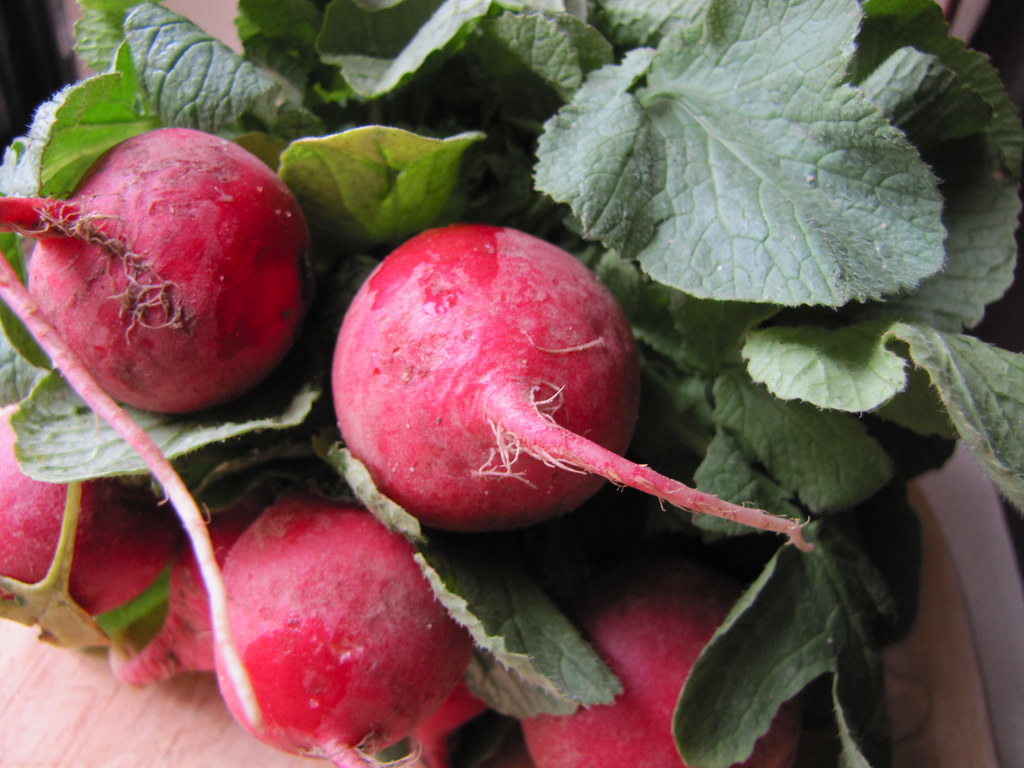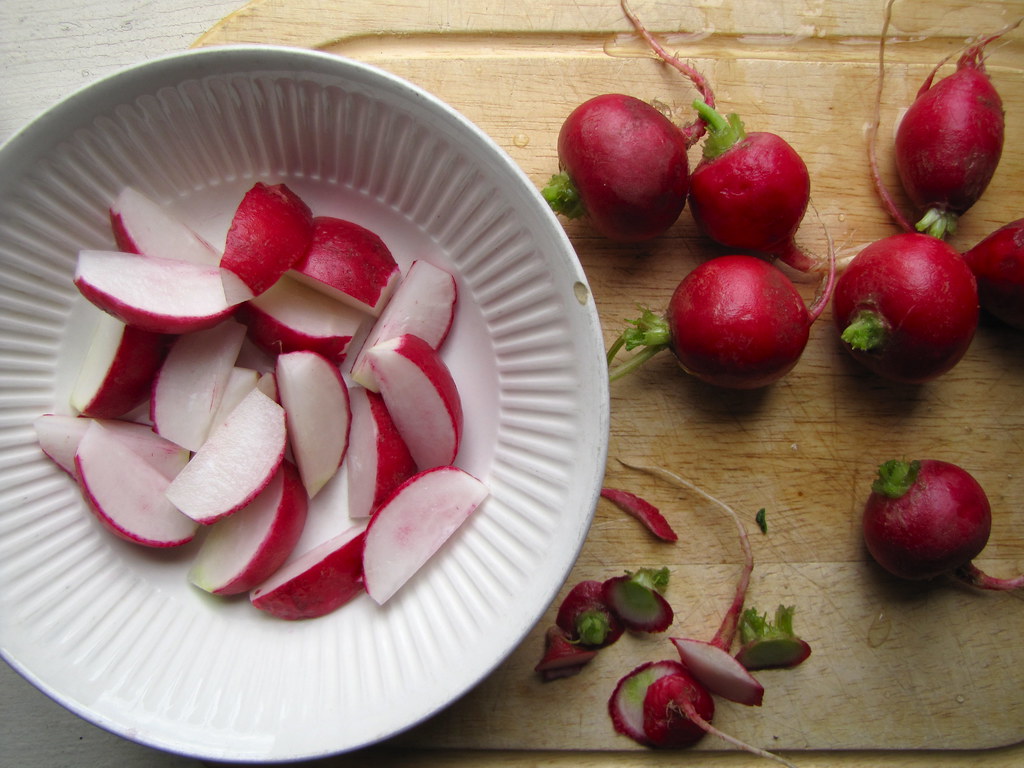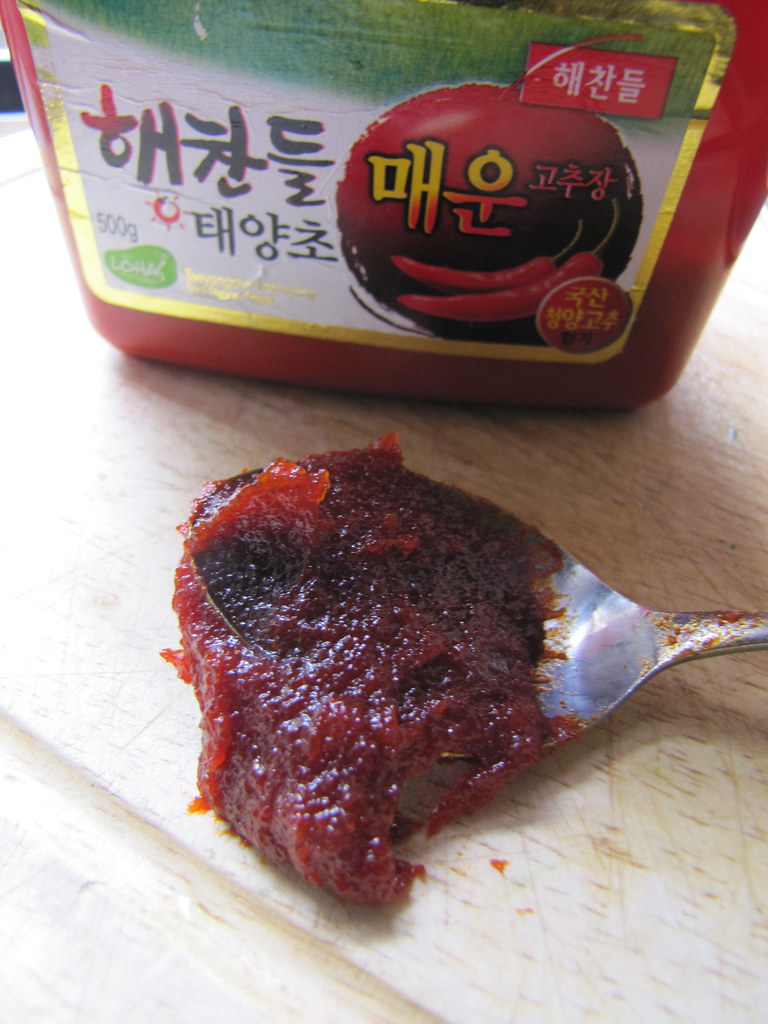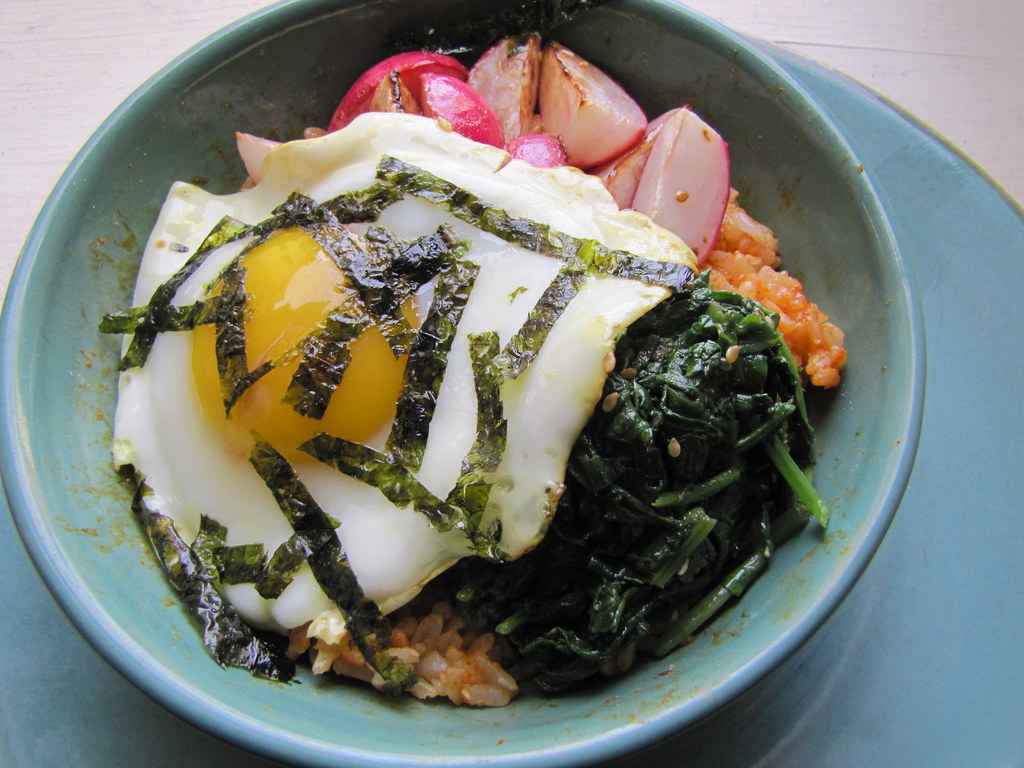
If that isn’t the most fun food name to pronounce, I don’t know what is. Bibimbap is lots of fun to make, too. It simply means, “mixed rice” in Korean and it’s an everyday, meal-in-one-bowl. Any vegetables you have on hand will do; you can marinate some sliced meat and sautee it to add, too. Then you just assemble everything on the rice, add a dollop of spicy gochujang and an egg to pop. You can mix in a little more than that, add fancier steps like grilling, or hot stone bowls that still cook. But that’s the basic swing of things — it’s the bibim bop, can you dig?
I can. Even though I only had some radishes for this round. To be sure, bibimbap is less of an exact dish than a serving suggestion, with its open-ended ingredient list. So I took the liberty of using just one, really — radishes — in addition to the customary fried egg. But guess what? When you get a bunch of them with their greens still intact, you’ve actually bought two veggies for the price of one. Radish greens may not be the best, or least bitter and tough leafy greens of them all. But they’re still wickedly nutritious, and I don’t mind the slight, hairy scruff on the surface of these leaves once sauteed. Go ahead and discard the hoariest ones of the bunch, any bruised or yellowed bits, too. One bunch of radishes should give you just the right amount to cook down in a quick sautee for something like this.
 a bunch of radishes
a bunch of radishes
As for the radishes themselves, any way you like ’em is fair game. Raw and sliced, or lightly sauteed, they’re a crisp, fresh-tasting addition. Radishes, what an underrated and versatile root.
 broken down to its tops
broken down to its tops
 and bobber-shaped roots
and bobber-shaped roots
These were the common sparkler radishes that I’d gotten at Grand Army Plaza Greenmarket last Saturday. With a mild peppery flavor and watery white flesh with a thin and perfectly edible red skin, it’s no wonder they’re the go-to variety, despite there being so many different radish types. I love the way the reddish-magenta dye streaks a little when slicing through them, and their rotund little shape. Instead of slicing them into flat discs, I prefer to cut wedges, just to see them a bit differently. And for this dish, I gave those clean, white pieces a bit of golden crust from a pan. Better to julienne them if you wish to serve them fresh.
 fermented Korean chile paste, gochujang
fermented Korean chile paste, gochujang
To get started on assembling this, cook the rice or reheat some that was leftover. A short-grain variety with a little stickiness would be the typical Korean rice to use, but you don’t have to if you prefer other types, like brown rice, which I do. The only thing that really makes this bowl bibimbap, instead of just “anything with rice,” is the certain Korean chile paste that gets mixed in with it, gochujuang. Made from dried Korean chiles and fermented beans, among many other things, it has a dark, smoky, and sweet complexity of flavors that is really unlike anything else. Spicy, it definitely is, too. It’s an ultra thick paste and it’ll stain everything in its path brick red. A little spoonful is all you’ll need per bowl, but size it to your own taste. Arrange the vegetables and meats you’ve cooked or cut up on top of the rice, and give yourself a scoop of this stuff to mix in.
The last addition to the bowl is adding a sunny side-up fried egg on top. I’ve been enjoying the huge, ridiculously orange-yolked ones from Flying Pigs Farm lately. The fresher the eggs, the easier they seem to fry — the whites don’t spill all over the entire pan.
 the whole bowl, with a garnish of nori seaweed and sesame seeds (optional)
the whole bowl, with a garnish of nori seaweed and sesame seeds (optional)
If you’re accustomed to having this dish in restaurants in a hot bowl that creates a beautiful crisped edge to the rice as you eat, you won’t get the same effect at home unless you have the proper equipment. I’m sure it’s neither too expensive nor hard to find, a stone bowl that can be preheated to 400+ degrees. Anyone with any suggestions on those, please fire away. But as a tiny-cupboard kitchen person, I’m hesitant to invest. For investigation’s sake, I tried to achieve something like this by preheating a regular, earthenware bowl in my home. But I only cranked up the oven to 350F, for fear it would break. Though it was hot, and the ingredients sizzled against its sides, the bowl still did not make the rice crispy, as hoped. Ah well, it still tasted really good, all the same.
Brown Rice and Radish Bibimbap
(makes 1 serving)
about 1 cup cooked brown rice
1 egg
about half a bunch of radishes
2-3 teaspoons sesame oil
salt and pepper to taste
1/2 tablespoon gochujang Korean chile paste (or more or less to taste)
vegetable oil
sesame seeds (optional)
slices of nori seaweed (optional, for garnish)
Separate the radish greens from the roots. Remove any bruised or yellowed leaves and discard. Wash, dry, and coarsely chop the remaining greens. Toss with about 1 teaspoon of sesame oil and season with a pinch each of salt and pepper. Cut the radishes into quarter wedges. Toss with about 1 teaspoon sesame oil and a pinch each salt and pepper.
Heat a heavy-bottomed or cast-iron pan. Add about 1 tablespoon vegetable oil and once hot, place down radishes on their cut sides. Don’t turn until after a minute, or once the bottom edges have slightly browned in parts. Turn and lightly brown on the other sides. Remove from pan. Add the radish greens and cook, stirring, occasionally, for 2-3 minutes. Remove from pan. Add additional vegetable oil and fry the egg sunny-side up.
Arrange rice in a serving bowl with the radishes and radish greens in small piles on top. Place the dollop of gochujang in the center. Once the egg is cooked, transfer to the bowl. Garnish with optional sesame seeds and nori slices, and serve immediately.
Cost Calculator
(for 1 serving)
1 cup cooked brown rice: $0.25
1/2 bunch radishes (at $3/bunch at the Greenmarket): $1.50
1 egg (at $4/dozen): $0.25
1/2 tablespoon Korean gochujang paste: $0.20
2-3 teaspoons sesame oil: $0.20
salt, pepper, vegetable oil, optional sesame seeds and nori: $0.35
Total: $2.75
Health Factor![]()
![]()
![]()
Three brownie points: It’s always a good sign when a dish is really colorful. Not only is this one really efficient meal to make, a good way to use up leftover rice and anything else on its way out, but it’s an efficient way to get all your food groups in one pop. At its most minimal preparation, which this one would surely be amongst, there is protein from the egg, and detoxifying and immune-boosting vitamins from the leafy radish greens. The radish roots contribute potassium, Vitamin C, and a health dose of nutrients for very few calories, too. Why only eat such small slices of them at a time?
Green Factor![]()
![]()
![]()
![]()
![]()
![]()
![]()
Seven maple leaves: It’s a good way to cook whatever you might have locally in season. Because it requires so little — or can require so little — meat, it’s a good way to use sustainable, responsibly raised animal proteins and not break your bank. Here, the radishes were some of the first bright red bunches of the spring, brought in from New Jersey to Grand Army Plaza Greenmarket last weekend. The egg was from upstate farm Flying Pigs, known primarily for their incredible pork. Can’t go wrong either way.
24 Responses
Szabe
Good stuff. Where do you get gochujang? I got some from Kalustyan’s once, but realized when I got home that it had fish in it. Any idea if a vegetarian gochujang exists?
esther
my mom actually pickles white radish and cuts them into strips to add to bibimbap!
Don’t forget to add a tiny dollop of sesame oil before mixing everything. 🙂
I was under the impression that gochujang was vegetarian! I could be wrong though.
cathy
Szabe: I’ve been able to find gochujang in pretty much any Asian grocery in Chinatown. Check out Kam Man on Canal St., it’ll definitely have that. And yes, a bit of fish or dried shrimp is pretty common in Asian sauces, and a hard taste to replicate… I don’t know of any gochujang in particular without, but I’d just read ingredient labels to see. Good luck!
Esther: Ah, good point about drizzling on the sesame oil at the end! I won’t forget next time 🙂
rob62521
This looks good…my husband planted radishes and we have a healthy crop right now.
Not Eating Out in New York » Brown Rice & Radish Bibimbap - wpparty.com
[…] under Recipes.you can leave a response, or trackback from your own […]
Ina
Great post! I love bibimbap! One tip my mom taught me about the gochujang sauce: I mix it with sesame oil, sugar and sesame seeds. This makes it a little easier to mix into the rice & veggies, and gives the flavor a little more depth.
The Nervous Cook
Bibimbap is one of my very, very favorite things on earth. It never really occurred to me to try it at home, though! Now I feel like it’s withing my reach…
I may never leave home again.
Nerdalert
This may be the bookie in me talking, but keep in mind that at $4/dozen, each egg costs $0.33, not $0.25. Eight cents may not dent anyone’s weekly budget, but somewhere, someday, Omar Khayyam will thank you for your accuracy.
bionicgrrrl
Yes, I agree with Ina, make a little gochujang sauce for the bibimbab as opposed to using it straight. Little sugar, rice vinegar, sesame oil, and water. Sesame oil is very important. In Manhattan I buy gochujang at Hmart on 32nd.
Beth Grim
Ever since I tried bibimbap in a restaurant, I’ve been fooling around with making it at home. It’s a good “farm” lunch, using whatever veggies are in the garden, and one of our fresh duck eggs. I still order it out, though, just to get that stone bowl thing…mmmm…
For me, one essential go-along is kim chee. I’ve not tried the gochujang, but will get some next time I’m at the Asian store.
Thanks for the nice post!
Mister Meatball
This is my all-time favorite Asian dish.
Grazie.
Fine work indeed.
cathy
Nerdalert: Ack! Thank you kindly!! Will try to be more accurate from now on. Thanks, all!
Cooking in a Pressure Cooker
[…] Not Eating Out in New York » Brown Rice & Radish Bibimbap […]
miloandnutella
I am a big fan of bibimbap. I had my first bowl on Telegraph Ave in Berkeley.
Natsumi
I think one trick of getting the rice to be crispy is to put some sesame oil in the bottom of the bowl before you add the rice in. That sizzles it up (: Definitely loving this recipe and I’m thinking it’ll be my winter comfort food!
gochujang
Gochujang is vegitarian. It only has four ingredients – cayenne pepper, soybean, sticky rice and sea salt.
Not Eating Out in New York » 5 Seasonal Veggies You Gotta Try This Thanksgiving
[…] Radishes: Radishes are one of the most prolific plants I have seen; they refuse to not grow into dainty red bulbs after just a few weeks from planting. It’s high time we found more uses for the easy-going source of fiber and Vitamin C, aside from just slicing them up to toss into salads. Melissa Clark had a great article about roasting radishes, and since then I’ve seen it done in restaurants here and there. Radishes vary incredibly; these are some watermelon radishes that are large and dense, good for slicing up raw but pretty cool to cook with, too. Recipe: Brown Rice & Radish BiBimBap […]
tn requin
good asnin
tn requin
http://www.sss.com
Vitamix
Wow a Bibimbap recipe! Hooray! My results were excellent, and the cost per serving was even lower- thanks!
Better-Next-Day Kimchi Wakame Soup | FOXY FRESHFOXY FRESH
[…] would have eaten this in Korea but I didn’t know what it was until I got home and read this recipe on the lovely Cathy Erway’s blog which explains what it is – it’s made from dried […]
PhenQ Coupon
PhenQ Discounts
[…]Seems like regular post[…]
Keyword2 is good
Click Here to Buy Now
Loved it amazing product…
Keyword1}
Click Here to Buy Now
Loved it amazing product…